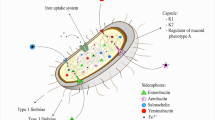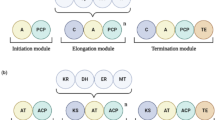Abstract
The effect of recombinant divercin RV41 (DvnRV41) and its structural variants on the K-channel formation was determined. The growth of Listeria monocytogenes EGDe (sensitive phenotype) and its isogenic strain (resistant phenotype) was assessed in the presence of DvnRV41 combined or not with pinacidil, NS1619, cromakalim (as K-channel activators), iberiotoxin and glipizide (as K-channel blockers). The combined action of DvnRV41 and K activators permitted formation of ATP-dependent pores. The combination of DvnRV41 and ATP-dependent pore activator cromakalim inhibited the growth of sensitive strain. The antilisterial activity of structural variants was less important than that of DvnRV41 but their mode of action remained overall similar.


Similar content being viewed by others
Abbreviations
- CRK:
-
Cromakalim
- GLZ:
-
Glipizide
- IBT:
-
Iberiotoxin
- NS1619:
-
A channel opener
- PCD:
-
Pinacidil
- AU:
-
Arbitrary units
- Dvn RV41:
-
Recombinant divercin
- LAB:
-
Lactic acid bacteria
- LB:
-
Luria–Bertani (broth)
- MIC:
-
Minimum inhibitory concentration
- PMF:
-
Proton motive force
- PTS:
-
Phosphotransferase system
- TSB:
-
Tryptic soy broth
- TSYEB:
-
TSB + yeast extract
References
Adams M (2003) Nisin in multifactorial food preservation. In: Roller S (ed) Natural Antimicrobials for the Minimal Processing of Foods. CRC Press, Boca Raton, pp 11–33
van Belkum MJ, Kok J, Venema G, Holo H, Nes IF, Konings WN, Abee T (1991) The bacteriocin lactococcin A specifically increases permeability of lactococcal cytoplasmic membranes in a voltage-independent, protein-mediated manner. J Bacteriol 173:7934–7941
Bieler S, Silva F, Soto C, Belin D (2006) Bactericidal activity of both secreted and nonsecreted microcin E492 requires the mannose permease. J Bacteriol 188:7049–7061
Brotz H, Josten M, Wiedemann I, Schneider U, Gotz F, Bierbaum G, Sahl HG (1998) Role of lipid-bound peptidoglycan precursors in the formation of pores by nisin, epidermin and other lantibiotics. Mol Microbiol 30:317–327
Candia S, Garcia ML, Latorre R (1992) Mode of action of iberiotoxin, a potent blocker of the large conductance Ca2+-activated K+ channel. Biophys J 63:583–590
Chen H, Hoover DG (2003) Bacteriocins and their food applications. CRFSFS 2:82–100
Cotter PD, Hill C, Ross RP (2005) Bacterial lantibiotics: strategies to improve therapeutic potential. Curr Protein Pept Sci 6:61–75
Diep D, Skaugen BM, Salehian Z, Holo H, Nes IF (2007) Common mechanisms of target cell recognition and immunity for class II bacteriocins. Proc Nat Acad Sci USA 104:2384–2389
Drider D, Fimland G, Héchard Y, McMullen LM, Prévost H (2006) The continuing story of class IIa bacteriocins. Microbiol Mol Biol Rev 70:564–582
Ennahar S, Sashihara T, Sonomoto K, Ishizaki A (2000) Class IIa bacteriocins: biosynthesis, structure and activity. FEMS Microbiol Rev 24:85–106
Evgenov OV, Pacher P, Williams W, Evgenov NV, Mabley JG, Cicila J, Sikó ZB, Salzman AL, Szabó C (2003) Parenteral administration of glipizide sodium salt, an inhibitor of adenosine triphosphate-sensitive potassium channels, prolongs short-term survival after severe controlled hemorrhage in rats. Crit Care Med 31:2429–2436
Glaser P, Frangeul L, Buchrieser C, Rusniok C, Amend A, Baquero F, Berche P, Bloecker H, Brandt P, Chakraborty T, Charbit A, Chetouani F, Couvé E, de Daruvar A, Dehoux P, Domann F, Domínguez-Bernal G, Duchaud E, Durant L, Dussurget O, Entian KD, Fsihi H, García-del PF, Garrido P, Gautier L, Goebel W, Gómez-López N, Hain T, Hauf J, Jackson D, Jones LM, Kaerst U, Kreft J, Kuhn M, Kunst F, Kurapkat G, Madueno F, Maitournam A, Vicente JM, Ng E, Nedjari H, Nordsiek G, Novella S, de Pablos B, Pérez-Diaz JC, Purcell R, Remmel B, Rose M, Schlueter T, Simoes N, Tierrez A, Vázquez-Boland JA, Voss H, Wehland J, Cossart P (2001) Comparative genomics of Listeria species. Science 294:849–852
Han X, Xi L, Wang H, Huang X, Ma X, Han Z, Wu P, Ma X, Lu Y, Wang G, Zhou J, Ma D (2008) The potassium ion channel opener NS1619 inhibits proliferation and induces apoptosis in A2780 ovarian cancer cells. Biochem Biophys Res Com 375:205–209
Héchard Y, Pelletier C, Cenatiempo Y, Frère J (2001) Analysis of σ(54)-dependent genes in Enterococcus faecalis: a mannose PTS permease (EII(Man)) is involved in sensitivity to a bacteriocin, mesentericin Y105. Microbiology 147:1575–1580
Herranz C, Chen Y, Chung HJ, Cintas LM, Hernández PE, Montville TJ, Chikindas ML (2001) Enterocin P selectively dissipates the membrane potential of Enterococcus faecium T136. Appl Environ Microbiol 67:1689–1692
Ingham A, Ford M, Moore RJ, Tizard M (2003) The bacteriocins piscicolin 126 retains antilisterial in vivo. J Antimicrob Chemother 51:1365–1371
Kišidayová S, Lauková A, Jalč D (2009) Comparison of nisin and monensin effects on cilitae and selected bacterial populations in artificial rumen. Folia Microbiol 54:527–532
Lauritzen I, De Weihe JR, Lazdunski M (1997) The potassium channel opener cromakalim prevents glutamate-induced cell death in hippocampal neurons. J Neuronem 69:1570–1579
Line JE, Svetoch EA, Eruslanov BV, Perelygin VV, Motsevich EV, Mitsevich IP, Levchuk VP, Svetoch OE, Seal BE, Siragusa GR, Stern NJ (2008) Isolation and purification of enterocin E-760 with broad antimicrobial activity against Gram negative and Gram positive bacteria. Antimicrob Agents Chemother 52:1094–1100
Littleton JT, Ganetzky B (2000) Ion channels and synaptic organization: analysis of the Drosophila genome. Neuron 26:35–43
Naghmouchi K, Drider D, Hammami R, Fliss I (2008) Effect of antimicrobial peptides divergicin M35 and nisin A on Listeria monocytogenes LSD530 potassium channels. Curr Microbiol 56:609–612
Pilet MF, Dousset X, Barré R, Novel G, Desmazeaud M, Piard JC (1995) Evidence for two bacteriocins produced by Carnobacterium divergens V41 and Carnobacterium piscicola V1 isolated from fish and active against Listeria. J Food Prot 58:256–262
Richard C, Drider D, Elmorjani K, Marion D, Prévost H (2004) Heterologous expression and purification of active divercin V41, a class IIa bacteriocin encoded by a synthetic gene in Escherichia coli. J Bacteriol 186:4276–4284
Richard C, Cañon R, Naghmouchi K, Bertrand D, Prévost H, Drider D (2006) Evidence on correlation between number of disulfide bridge and toxicity of class IIa bacteriocins. Food Microbiol 23(2):175–183
Řiháková J, Petit VW, Demnerová K, Prévost H, Rebuffat S, Drider D (2009) Insights into structure–activity relationships in the C-terminal region of divercin V41, a class IIa bacteriocin with high-level antilisterial activity. Appl Environ Microbiol 75:1811–1819
Řiháková J, Cappelier JM, Hue I, Demnerová K, Fédérighi M, Prévost H, Drider D (2010) In vivo activity of recombinant divercin V41 and its structural variants against Listeria monocytogenes. Antimicrob Agents Chemother 54:563–564
Rodríguez JM, Martinez MI, Kok J (2002) Pediocin PA-1, a wide-spectrum bacteriocin from lactic acid bacteria. Crit Rev Food Sci Nutr 42:91–121
Schneider T, Kruse T, Wimmer R, Wiedemann I, Sass V, Pag U, Jansen A, Nielsen AK, Mygind PH, Raventos DS, Neve S, Ravn B, Bonvin AM, De Maria L, Andersen AS, Gammelgaard LK, Sahl HG, Kristensen HH (2010) Plectasin, a fungal defensin, targets the bacterial cell wall precursor lipid II. Science 328:1168–1172
Stern NJ, Svetoch EA, Eruslanov BV, Perelygin VV, Mitsevich EV, Mitsevich IP, Pokhilenko VD, Levchuk VP, Svetoch OE, Seal BS (2006) Isolation of a Lactobacillus salivarius strain and purification of its bacteriocin, which is inhibitory to Campylobacter jejuni in the chicken gastrointestinal system. Antimicrob Agents Chemother 50:3111–3116
Suzuki M, Yamamoto T, Kawai Y, Inoue N, Yamazaki K (2005) Mode of action of piscicocin CS526 produced by Carnobacterium piscicola CS526. J Appl Microbiol 98:1146–1151
Tagg JR, Dajani AS, Wannamaker LW (1976) Bacteriocins of Gram-positive bacteria. Bacteriol Rev 40:722–756
Thorne GD, Conforti L, Paul JR (2002) Hypoxic vasorelaxation inhibition by organ culture correlates with loss of K+ channels but not Ca2+ channels. Am J Physiol Heart Circ Physiol 283:H247–H253
Todorov SD, Wachsman M, Tomé E, Dousset X, Destro MT, Dicks LMT, de Gombossy Melo Franco BD, Vaz-Velho M, Drider D (2010) Characterization of an antiviral pediocin-like bacteriocin produced by Enterococcus faecium. Food Microbiol 7:869–879
Wachsman MB, Castilla V, de Ruiz Holgado AP, de Torres RA, Sesma F, Coto CA (2003) Enterocin CLR35 inhibits late stages of HSV-1 and HSV-2 replication in vitro. Antivir Res 58:17–24
Acknowledgment
The authors would like to thank J. Baah for improving quality of the manuscript and the French Embassy in Prague for financial support of first author.
Author information
Authors and Affiliations
Corresponding authors
Rights and permissions
About this article
Cite this article
Rihakova, J., Prevost, H., Demnerova, K. et al. Effect of recombinant divercin RV41, structural variants and the activators of potassium channels on Listeria monocytogenes EGDe. Folia Microbiol 56, 110–115 (2011). https://doi.org/10.1007/s12223-011-0024-2
Received:
Accepted:
Published:
Issue Date:
DOI: https://doi.org/10.1007/s12223-011-0024-2




